Macellaio – Paolo Novembrini
Paolo’s butcher shop is in the town of Moie 9km from Jesi, it is the same town that Chef Giuliano Pediconi is from. Paolo arrived to the school in a small refrigerator truck in which a ½ of cow and a ½ of pig were hanging. Paolo comes from a family of butchers; his father and grandfather were butchers. He says “it is in his blood, he has a passion for butchery, and it is not just a job”. He also stated that his family is the first consumers of his products, so they have to be great. Paolo was not only a butcher, but a certified Body Builder and Trainer (he showed me the official cards-but I could see the muscles myself). Paolo was serious guy; we had a great conversation regarding the eating of meat, fat and vegetarians and what the human body needs to be healthy. You would never convince Paolo to stop eating meat. It is important to note that like the cuisine of Italy, the butchery and cuts of meat can vary from region to region.
· Macellaio – the butcher
· Macellerira – the butcher shop
Paolo picks his animals while they are alive and still fairly young so he can establish a relationship with the animal, see how it is raised, he knows the animals’ food, and how the animal was cared for. The beef side he brought in had his name written on the inside rib of the carcass. The carcass also had an official tag on it with a tracking number, stated where it was born, raised, and slaughtered. And a blank line, butchered by-because the animal was bought by him whole.
The breed of cow was typical of Marche, and is called Grasso Marchigiana. The ½ of cow was about 12 months old and weighed 126kg and cost between 7 & 8 Euro per kg. The back 2/3’s of the cow is called the Pistola Longa, the long gun. The butcher deftly and swiftly began to dismantle this into pieces: Pancia – Belly, Lombata –loin, Filetto – Filet, (he took of the loin and filet together with the head of the filet exposed – Testa del Filetto – he did this to cut Bistecca (T-bones from the loin), Sotto Fresa–Rump, Girello – Eye Round, Noce – round, Fesa Interna-Inside round, Codone –tri tip, Campanella (little bell) – back of shank, Muscolo Disosatto-lower shank without bones. The front part he broke into three parts at first-Spalla –Shoulder, Petto-Breast, Collo – Neck, and then broke down those – the skirt, Bianco Costato –White Ribs –the inside of the belly after removing the bones, Golla – Throat –for ground meat, Girello di Spalla – Shoulder Round, Fesa di Spalla – Shoulder Rump, Punta de Spalla – Top of shoulder, Collo – the over meat of the neck for ground beef, Costata – front of the loin – steak, and other pieces to be ground.
Maile – Pork
The butcher first laid out several cured cuts of meat on the table in the shape of a pig and then he brought in the ½ of pig that was about 6 months old when slaughtered. We discussed the cured meats and where they came from the pig.
We discussed the fat on the pig and the different qualities.
· Golla – fat from the throat – it is the best fat because the animal is born with it-it has the most flavor
· Strutto – Fat Back – 2nd in quality for taste
· Pancetta – belly fat – the newest fat on the animal – therefore the least flavorful. Paolo says you can taste the difference if you start a dish with Golla as opposed to Pancetta, and I believe him-he was serious
He showed how to remove the skin and meat off the face for Guanciale – the cheek – it is cured like pancetta. Surprisingly to me it does not contain the actual round of cheek meat. He said the cheek meat is used in Coppa di Testa (head Cheese). He took the skin of the feet for Zampone. Removed the rear leg and trimmed for Prosciutto – he rubs his for 20-28 days with salt, washes and hangs to dry for 15-16 months at 4-5 degrees C. He showed us how to cut the thigh for Culatello- basically a boneless prosciutto from the best part of the leg - with the Noce removed. When he trimmed the pancetta he cut off the bottom –the breast because it was a female pig. For his Pancetta he rubs with the cure for 8 days with 3.5-4% salt mix and spices, then cleans and rolls and hangs for at least 90 days. He said the best pancetta’s hang for 90 or more days. The collo –neck he cleaned and showed how it can be used as a roast or for curing. For the neck he cures it 8 to 10 days, then washes, and then hangs for 90-100 days at 10-12 degrees C.
The cured pieces he brought were Guancialle, Collo, Lombo, Pancetta, Soppressato, Fabriano, and Prosciutto. We ended our day by tasting all the cured meats made by Paolo and discussing the wonderful items you can prepare from meat. The cured meats were all excellent.
Subscribe to:
Post Comments (Atom)











































































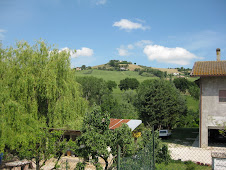

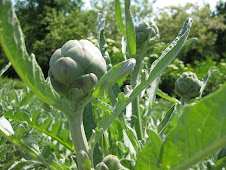


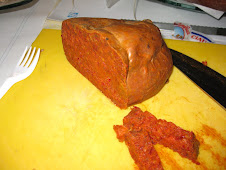
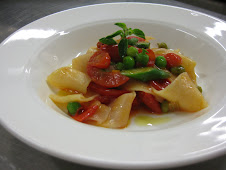
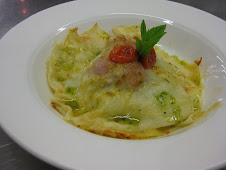
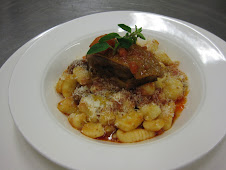








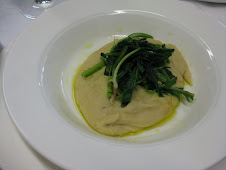

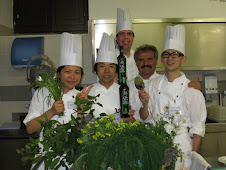
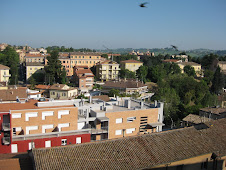


1 comment:
I tasted, with the Garde Manger class, the Salami we made from Sami’s pigs. Tears came to my eyes. It is so good, you have to come back and taste it. It melts in your mouth and the sour taste is just perfect.
Post a Comment